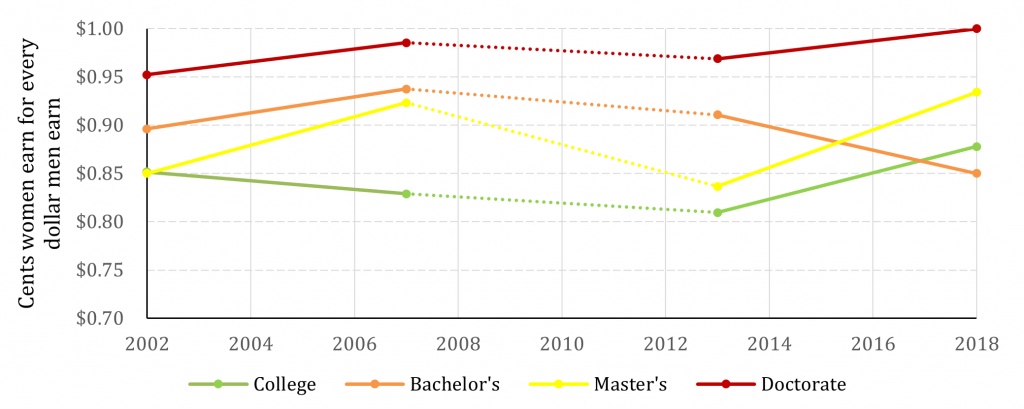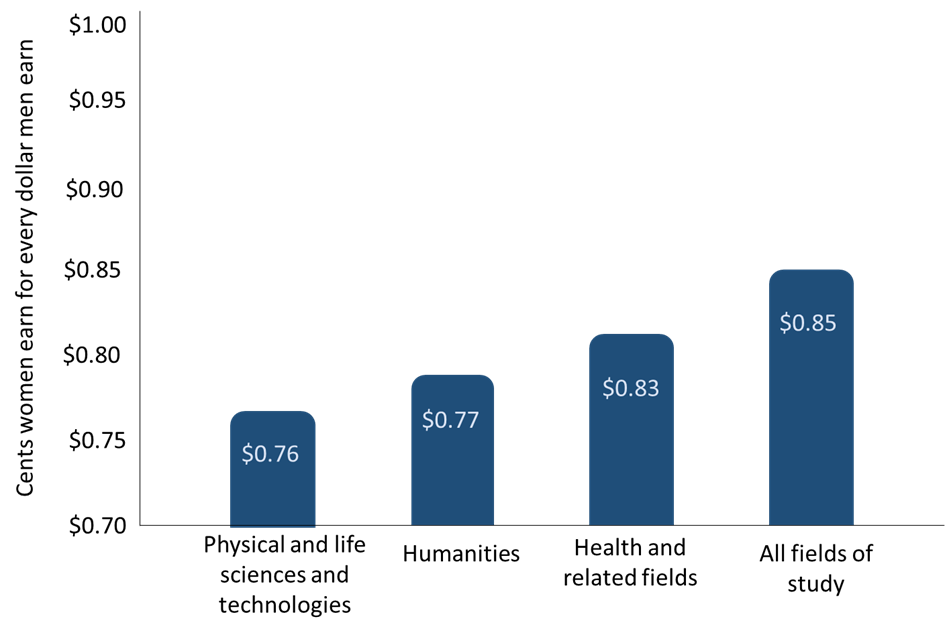International Women’s Day is a good time to once again take stock of gender inequality in earnings. This is unfortunately not a new issue. According to the Organization for Economic Cooperation and Development (OECD), Canadian women continue to earn less than men. In 2019, women earned, on average, 18% less than men. The wage gap begins immediately following graduation from postsecondary and increases with each year in the workforce. This virtually guarantees that earnings gaps experienced by today’s graduates will continue to grow — leading to a future with ongoing gender inequality in wages.
Recent Statistics Canada data illustrates troubling discrepancies. For example, women earn just $0.76 for every dollar earned by men three years after graduation with a physical and life sciences degree from an Ontario postsecondary institution. Over a three-year period, this earnings differential can add up to $40,000 for women.
Ontario Women Graduates Continue to Earn less than Men

Notes: Results are for full-time workers, only. The first two data points are separated from the later ones with a dotted line to signify that followup intervals changed from two to three years during this time; data should be compared with caution.
Source: National Graduates Survey. Statistics Canada Table 37-10-0034-01
The graph illustrates that the gender wage gap persists among all but a small subset of Ontario graduates. Women doctorate recipients have the smallest wage gap for all survey periods and were at parity with men in 2018. This is in sharp contrast to women college graduates who earn roughly $0.85 for every dollar men earn over the time period. Master’s and bachelor’s degree recipients have experienced middling disparities, ranging from $0.85 to $0.94.
The gender wage gap for women with a bachelor’s degree is troubling given that the majority of university graduates hold this credential. In 2013, three years after graduation, women earned $0.91 for every dollar earned by men; this dropped to $0.85 in 2018 for the 2015 cohort of graduates.
Women Graduates Earn far less than Men in some Fields

Notes: Results are for postsecondary graduates employed at the time of the follow-up survey.
Source: 2018 National Graduates Survey. Statistics Canada Table 37-10-0188-01
The graph above shows the three subject areas with the largest earnings gaps between women and men in 2018. To better illustrate the “real world” impacts of these disparities, we have estimated the cumulative income gaps for women in these fields compared to men. Over a three-year interval, the 2018 gap would result in an earnings deficit of $42,600 for women graduates of physical and life sciences, $39,000 for humanities, and $30,900 for health and related fields. These wage gaps are likely to grow over time, thereby increasing these disparities.
There are a few bright spots to be found. Women from mathematics, computer, and information sciences fields as well as architecture, engineering, and related technologies fields are roughly at parity in earnings with men. In personal, protective and transportation services fields women earn slightly more. However, the prevailing trend remains that most women earn substantially less than men that studied in the same fields.
We are approaching the first anniversary of the effects of the pandemic in North America and there are reports that the fallout could set women in the workforce back by 10 years. However, with more companies shifting permanently to work-from-home models, there is an opportunity for large-scale overhauls of previous longstanding work environments. Of course, a work-from-home paradigm does not in and of itself guarantee more opportunities for women who continue to juggle the lion’s share of home and child responsibilities.
There have been some recent policy developments aimed at supporting women. The Canadian government has announced a Feminist Response and Recovery Fund which aims to increase the participation of girls and women in economic, social, democratic and political life. There are also additional federal pay equity regulations being developed that should help equalize wages for women, but it is unclear yet whether these will achieve their intended effect.
HEQCO is currently investigating gender disparities among academics in Ontario and across Canada to better understand the challenges faced by women in academia and beyond. While recent women graduates with doctorates appear to have reached parity in earnings with men, women faculty have not. They are often “outnumbered and outearned,” earning, on average, $14,437 less than men in the same discipline per year. As we continue to explore this issue, we hope to shine a spotlight on the gaps that persist and propose policies to help combat them.
Jeffrey Napierala is a senior researcher and Shakira Leslie is a research intern at the Higher Education Quality Council of Ontario.
Notes on the data: The National Graduate Survey was used to examine early career earnings for PSE graduates. To show trends over time, we compared the earnings of graduates from 2015, 2010, 2005 and 2000. For the 2015 and 2010 cohorts, data was collected three years after graduation. For the 2005 and 2000 cohorts, data was collected two years after graduation. For the purposes of this blog, HEQCO used nouns referring to gender instead of sex when presenting results, despite incongruencies between the two concepts.
Earnings reported above are either computed from, or are, the median of annual gross earnings for men and women graduates. They are unadjusted for additional characteristics that may differently affect earnings for men and women, such as years of labour force experience, the number of hours/weeks worked and/or, the precise degree earned. Consequently, it is possible that other characteristics may be affecting observed gaps as well as gender.
